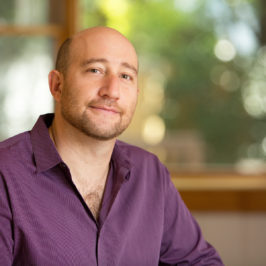Thirty-odd years ago, at the age of 12, I experienced a brutal sexual assault. It’s taken me until now to write about it. Last summer, I published a memoir essay titled “Sweetness Mattered” in Tin House recounting this story, and this summer, I’m coming out with a novel, Nirvana Is Here, a fictional version inspired by these events.
Having crossed this same river twice, I want to share what I learned while writing in response to a #metoo moment, not only in terms of craft but also the writing process and its psychic tolls and rewards.

‘Writing my story both as fiction and nonfiction was a challenge…’ Illustration by Josh Quick
As survivors of sexual assault, some of us have kept our stories hidden for a while. Now that we’ve decided to speak, we may feel impelled to finally unburden ourselves and share our experiences with our readers in as much vivid detail as we can muster.
On the flip side, some of us may still feel some reluctance to share our stories, and so we may hold back details that readers need to know in order to understand what we’ve been through.
I’ve experienced both extremes.
In the original drafts of my novel, I fleshed out scenes of sexual assault in scrupulously reported minute-by-minute detail. Also, because my story focused on the after-effects of the assault on the main character, I placed these excruciating scenes at the beginning of the manuscript.
Early readers pointed out that these narrative decisions made it difficult for them to enter the story. In part, I think this reaction is due to the fact that details on the page reverberate more loudly than they do in life. As consumers of stories, we’ve become used to reading details as a kind of narrative shorthand, meant to suggest many other details that a story doesn’t have the capacity to include.
For example, if I see someone on the street smoking a cigarette, I think, oh, there’s someone smoking a cigarette. If I see a scene of someone on the street smoking a cigarette in a Hollywood movie, I think, oh, that must be the serial killer.
In revising my novel, I slowly and methodically doled out bits of the sexual assault. These culminated in a brief flashback scene placed at a climactic moment in the present-day story that showed how the past assault affected the character’s romantic relationships going forward. In my case, I found this strategy worked in two ways.
First, it helped readers navigate the difficult subject matter. Second, it was more authentic to the experience, which was so horrific at the time that I wasn’t fully there to experience it. Only in remembering it, in flashes, did these events become real in my life.
Conversely, while writing this story as nonfiction, I took the opposite route, skating over the details of the assault. In response, an editor wrote to me and asked if I could share more, noting that even the language I’d used in describing the assault felt “a little rote.” The reader might wish to know a bit more, “not that you need to go into great detail.”
I read those words with dread. Writing in a fictional way about my story, though difficult, allowed me more freedom to open up. Writing my story as nonfiction felt more painful, even nauseating.
What saved me here were the words “not that you need to go into great detail.” The technique of impressionism, selecting vivid details that give the reader just enough information, was key here, not only for my own well-being, but also again, to authentically portray actual events. In his essay “This Is Your Brain on Fear: Trauma and Storytelling,” writer J. T. Bushnell points out that in times of fear-induced stress, we experience time in a non-linear way, as a series of vivid, specific, yet disconnected details.
Recreating a scene of trauma in a logical and linear way may actually defeat the ultimate purpose of writing it: to convey the horror. An example of this is the rape scene in the film The Accused, which includes so much detail that for some viewers it turns a tragedy into a spectacle.
Ultimately, writing my story both as fiction and nonfiction was a challenge that was markedly different from other challenges I’ve faced as a writer, like trying to capture a culture that wasn’t my own, or writing an intense scene of violence that I’d imagined out of thin air. Whatever topic I’m writing about, I find that I need to put myself in a kind of trance and imagine a scene fully in order to bring it to life on the page.
The process of reliving my assault time and time again as I made craft decisions about just the right words to use or which details to include often became too much to bear. At times, I had to walk away from my text and take a long walk with my dog, or sit on my front porch and listen to the wind rustling through the trees, repeating a mantra my therapist taught me. “I am not 12 any more. I’m here, now.”
Those are some of the costs of writing my #metoo story. Now let me share a few of the rewards, beginning with the fact that telling my story means owning my story. I used to fear that people would find out what had happened to me. Now that fear is gone. That source of vulnerability has now become a place of strength. In other words, it’s a power move.
In addition, the overwhelmingly empathetic response to my work is like nothing I’ve experienced in my 20-year career. Readers, whether they’ve had a similar experience or not, feel a direct emotional connection to my writing that is gratifying.
Ultimately anyone considering writing a #metoo story has a unique decision to make, about whether to tell it and how to do so. I can only say that in my case, it’s made me a stronger, surer person and writer.

